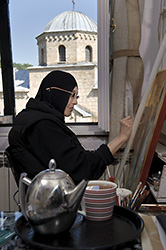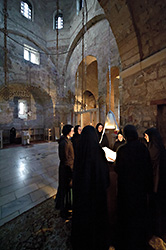Life, Novels
MOTHER EFIMIJA, PRIORESS OF GRADAC MONASTERY, FROM LIFE IN ART TO LIFE IN CHRIST
Strange Are the Ways of God
A modern Belgrade girl, who grew up with the music of ”Zeppelin” and ”Stones”. Excellent student of the Academy of Arts, rising star in painting. Favorite. However, she continuously ”felt within an unexplainable deep sorrow, need for fullness and longing for something bigger than the material. She saw herself at the end of the world, gazing at the horizon, the sky, eternity. She sought. And God never imposes Himself…” The decision wasn’t easy. Today she knows that ”she found herself in something much deeper than anything she could have imagined”
By: Viktor Dražen
Photo: Svetlana Dingarac
 One spring, in the fifth decade of the XIII century, Helen of Anjou started off an unknown road, to meet her future husband, Serbian king Stefan Uroš I. The legend goes that the Serbian king planted lilacs along the entire Ibar valley, from Kraljevo to Raška, to show the bride his love and cover the sharpness of the landscape, as well as to have something to remind the future queen of her homeland, to feel more comfortable in her new home. Helen, whose biography remains little known, gave Serbia the first female school in these lands and erected several churches and monasteries, including Gradac, the most famous one among them. In that monastery we meet prioress Efimija, who came to Gradac through the Valley of Lilacs more than 800 years after Helen of Anjou, but in similar circumstances – entering a new life, not knowing exactly what expects her on that path, but determined to persist. One spring, in the fifth decade of the XIII century, Helen of Anjou started off an unknown road, to meet her future husband, Serbian king Stefan Uroš I. The legend goes that the Serbian king planted lilacs along the entire Ibar valley, from Kraljevo to Raška, to show the bride his love and cover the sharpness of the landscape, as well as to have something to remind the future queen of her homeland, to feel more comfortable in her new home. Helen, whose biography remains little known, gave Serbia the first female school in these lands and erected several churches and monasteries, including Gradac, the most famous one among them. In that monastery we meet prioress Efimija, who came to Gradac through the Valley of Lilacs more than 800 years after Helen of Anjou, but in similar circumstances – entering a new life, not knowing exactly what expects her on that path, but determined to persist.
Explaining for National Review how she decided to spend her new life in the Monastery of Gradac, which was practically desolated at the time of her arrival and in which she found only old mother Ana and her future spiritual guardian father Julijan, Efimija says that her interest in the history of art and search for beauty took her to this monastery already in her youth, when she didn’t even dream that she would replace her urban, artistic life with life in a monastery.
 ”My first encounter with the Gradac Monastery in the late 1980s, left a lasting trace in my heart. A church in a completely unreal place, as if lowered from heavens to a green carpet. A sight to remember. Much later, when I realized I wanted to go to a monastery, I knew that was the place I’d live in, and the first time I was here, I knew it was the place I’d return to.” ”My first encounter with the Gradac Monastery in the late 1980s, left a lasting trace in my heart. A church in a completely unreal place, as if lowered from heavens to a green carpet. A sight to remember. Much later, when I realized I wanted to go to a monastery, I knew that was the place I’d live in, and the first time I was here, I knew it was the place I’d return to.”
It wasn’t easy to make such a decision, she says. One is prone to holding on to the known, even if he is not exactly satisfied with the existing. ”I think I had everything one could wish for. Still, I continuously had the feeling I don’t belong there, that there is another place for me. I read more about the life of monks-hermits and felt close to them. I finally realized that was my world and gave it a try. I went to a monastery for a short time (a month) and decided there that I want and have the courage to start off into the unknown. The monastery truly gave me what I longed for and sought.”
 But, what made a Belgrade girl, who grew up on the music of ”Led Zeppelin”, ”Rolling Stones” and ”Azra”, who found the slag of a tennis court more natural than meadow grass, who never spent more than a week in the country, replace for good the lights of Belgrade and other European metropolises, for the stars of the Golija sky? Why did she reject the magic her rising artistic career offered her and replaced it with monastic humbleness and asceticism? Mother Efimija says that, ever since her early youth, she tried to be a good student, a good painter and therefore fulfill the form of living in the world. ”I fit well everywhere. I believe I was seemingly the same as other young people. I lived and loved life, loved art. The Academy for me was a place of complete dedication of myself to art. I loved movies, theaters, friends, summer and winter holidays, but all that couldn’t satisfy my need for something bigger than this life, which I felt deep in myself.” But, what made a Belgrade girl, who grew up on the music of ”Led Zeppelin”, ”Rolling Stones” and ”Azra”, who found the slag of a tennis court more natural than meadow grass, who never spent more than a week in the country, replace for good the lights of Belgrade and other European metropolises, for the stars of the Golija sky? Why did she reject the magic her rising artistic career offered her and replaced it with monastic humbleness and asceticism? Mother Efimija says that, ever since her early youth, she tried to be a good student, a good painter and therefore fulfill the form of living in the world. ”I fit well everywhere. I believe I was seemingly the same as other young people. I lived and loved life, loved art. The Academy for me was a place of complete dedication of myself to art. I loved movies, theaters, friends, summer and winter holidays, but all that couldn’t satisfy my need for something bigger than this life, which I felt deep in myself.”
SUMMONED FOR SOMETHING BIGGER
 ”My friends and acquaintances often ask me why my sister went to the monastery. Was it because of unfortunate love, disappointment in life? It was difficult to break the completely wrong stereotype and explain that these are not reasons why people go to monasteries. With Efimija, there weren’t even traces of it. My impression then was that it was completely the contrary, that she had everything in life – from a successful career and money, to luck in love and friendship”, says her brother Filip Rodić, who currently works as a Serbian diplomat in Brussels. ”For example, I will tell you about an accidental encounter I had with a Slovenian gallery owner to whom I mentioned by the way that my sister was a painter and now a nun. After looking at me with surprise, the man said her name, told me the smallest details from her life and stated the paintings I then held in my apartment. He ended the monologue about my sister with words, which even to me, completely non-objective when it comes to her, seemed as exaggeration: ‘If she were born in Paris or New York, she would be a new Picasso.’” ”My friends and acquaintances often ask me why my sister went to the monastery. Was it because of unfortunate love, disappointment in life? It was difficult to break the completely wrong stereotype and explain that these are not reasons why people go to monasteries. With Efimija, there weren’t even traces of it. My impression then was that it was completely the contrary, that she had everything in life – from a successful career and money, to luck in love and friendship”, says her brother Filip Rodić, who currently works as a Serbian diplomat in Brussels. ”For example, I will tell you about an accidental encounter I had with a Slovenian gallery owner to whom I mentioned by the way that my sister was a painter and now a nun. After looking at me with surprise, the man said her name, told me the smallest details from her life and stated the paintings I then held in my apartment. He ended the monologue about my sister with words, which even to me, completely non-objective when it comes to her, seemed as exaggeration: ‘If she were born in Paris or New York, she would be a new Picasso.’”
 Mother Efimija explains her path from the Academy to Gradac with a longing for something greater than material life and answers which ”her being sought through art”. ”It was present in each moment of my days. Most often I didn’t know what it was, but it was an unexplainable sorrow and longing for something ordinary life couldn’t offer me. I sought… God never imposes Himself… I saw myself at the end of the world, gazing at the horizon, the sky, eternity. What answers have I sought? To Mother Efimija explains her path from the Academy to Gradac with a longing for something greater than material life and answers which ”her being sought through art”. ”It was present in each moment of my days. Most often I didn’t know what it was, but it was an unexplainable sorrow and longing for something ordinary life couldn’t offer me. I sought… God never imposes Himself… I saw myself at the end of the world, gazing at the horizon, the sky, eternity. What answers have I sought? To  questions asked by my soul. Who I am, what the meaning and purpose of my life is. Art offered me the possibility of endless searching; compared to that, everything else lost its ‘color’. However, the anticipation of eternal life, which opened up to me through exhausting work, slowly and surely extinguished the beauty and charm of everything around me and opened me the door of life in the Holy Church, life in Jesus Christ. Now, after all these years, I don’t know any more whether I have really found what I thought I was looking for in my youth. What I did find myself in, however, is much better and much deeper than anything I could imagine.” questions asked by my soul. Who I am, what the meaning and purpose of my life is. Art offered me the possibility of endless searching; compared to that, everything else lost its ‘color’. However, the anticipation of eternal life, which opened up to me through exhausting work, slowly and surely extinguished the beauty and charm of everything around me and opened me the door of life in the Holy Church, life in Jesus Christ. Now, after all these years, I don’t know any more whether I have really found what I thought I was looking for in my youth. What I did find myself in, however, is much better and much deeper than anything I could imagine.”
We ask whether lilacs covered the rocks above the trail threatening to crumble on her monastic path as well. She explains that spiritual life is impossible to imagine, one must start off into it, like it’s necessary to dive into the sea to know how it is.
”When you enter, you see it’s not so easy, but the entire life in Christ is described in the Gospel. Whoever takes his cross and starts after Him should know that the path awaiting for him is the one Christ has already passed – we only follow Him: the prayer in Gethsemane, bloody sweat, students sleeping while He is praying, betrayal, mocking, dishonor, and finally the brutal and humiliating death on the cross. That is the path.”
ONE’S LIFE FOR THE ”LIFE OF THE WORLD”
 ”Each one of us will pass that road as much as one can stand, if there is strength and the wish to endure to the end. Who doesn’t want to, has no obligation to go down it. It’s possible to live in Christ our Lord in other ways too. This is the road of only those who wanted to be like Him, to give their life for the ‘life of the world’. What does that mean? To spend their lives by sharing the suffering of others, praying for the entire world, living in humility”, says mother Efimija. ”Each one of us will pass that road as much as one can stand, if there is strength and the wish to endure to the end. Who doesn’t want to, has no obligation to go down it. It’s possible to live in Christ our Lord in other ways too. This is the road of only those who wanted to be like Him, to give their life for the ‘life of the world’. What does that mean? To spend their lives by sharing the suffering of others, praying for the entire world, living in humility”, says mother Efimija.
Reminding that every day is a battle, she describes her attitude towards problems and dilemmas in life with the words of Jesus Christ who told His Father: ”If it be possible, let this cup pass from me: nevertheless not.” And adds that life in the monastery consists of everyday questioning ”can I do it or not?” because ”temptations are great and always on the border of our abilities, but the journey has begun and there is no turning back”.
Mother Efimija, however, emphasizes that life in the monastery offers great happiness, only if one can find and feel the joy of living in a community, in a community of people with God. ”It is difficult, but it cannot be compared to anything else. While I was living in the world, I carried within a deep, constant sorrow, need for fullness, here and now. Often it’s not easy for me, but the joy never ceases, neither does the hope in living in an eternal community with people and god.”
 Almost twenty years after she had left to the monastery, she believes that, for such a decision, it’s most important that one is mature and ready to confront oneself. ”I often speak with those who have a dilemma, who want to go to the monastery but aren’t sure. Many want to save themselves from this world, look for love and attention, friendship, community in the monastery. I must be very careful in such cases. Only mature people can survive in the monastery, spiritually mature people (regardless of age), who aren’t running from anything, but are ready to begin a battle against themselves, to carry the burden of this world. Love is continuous giving, there is no looking for love for ourselves, we leave it in the world. We come to the monastery to learn to give ourselves continuously and entirely. There is no room for whining.” Almost twenty years after she had left to the monastery, she believes that, for such a decision, it’s most important that one is mature and ready to confront oneself. ”I often speak with those who have a dilemma, who want to go to the monastery but aren’t sure. Many want to save themselves from this world, look for love and attention, friendship, community in the monastery. I must be very careful in such cases. Only mature people can survive in the monastery, spiritually mature people (regardless of age), who aren’t running from anything, but are ready to begin a battle against themselves, to carry the burden of this world. Love is continuous giving, there is no looking for love for ourselves, we leave it in the world. We come to the monastery to learn to give ourselves continuously and entirely. There is no room for whining.”
Thinking of her monastic life up to now, mother Efimija says that these twenty years weren’t enough for her to draw a line and say whether she had made the right decision when she started off that path, yet she has no regrets. ”This life is so short. Most people believe that we should use the best we can from life, ‘make’ something, leave something behind, ‘live’. You know what it means… We in the monastery also feel how limited our life on earth is, never enough praying. I feel more every day how much I need God and how far I still am from Him. We, people, change so slowly. I haven’t achieved anything special in terms of spiritual growing during these twenty years, so there is no possibility for me to think whether it was the right choice or not. I think that, if I had several more lives, it wouldn’t be sufficient to achieve everything I should. Luckily, after this temporary life, eternal life and endless possibilities await us. What we don’t achieve in time, God will give us in eternity.”
”YOUR WILL BE DONE”
 She never regretted starting off this path, she says, and it would be hard for her if, for some reason, she would have to give up this way of life. It seems to her she would ”dry out”. She mentions that she means only the way of life and relation to God, not the surrounding and place, because monks and nuns ”know well that they are only passers-by in this world, who own nothing and bond with nothing”. ”I could change anything, provided that I don’t betray God. We live with a blessing, which means we follow God’s will. It’s not about what I want, but what is needed, what is ‘most economical’ for the Holy Church. It’s true I like Gradac and I don’t like to think about what would happen if I had to start down another road again.” She never regretted starting off this path, she says, and it would be hard for her if, for some reason, she would have to give up this way of life. It seems to her she would ”dry out”. She mentions that she means only the way of life and relation to God, not the surrounding and place, because monks and nuns ”know well that they are only passers-by in this world, who own nothing and bond with nothing”. ”I could change anything, provided that I don’t betray God. We live with a blessing, which means we follow God’s will. It’s not about what I want, but what is needed, what is ‘most economical’ for the Holy Church. It’s true I like Gradac and I don’t like to think about what would happen if I had to start down another road again.”
For her, however, Gradac is not only a place, a beautiful old church, location, nature, but, what’s more important, the spirit of the community created there, the sisters who, like her, feel they belong there. ”When I’m far from the monastery, that is, my home, I don’t think about the green grass and mountains surrounding us, I think about the joy, the sisters who bravely fight, always witty, happy with small things, suffering with both known and unknown people… That is Gradac.”
***
Monastic Life and Conceptual Art
During the first years of her monastic life, she didn’t even think about painting and almost completely forgot about contemporary art and the artistic world, says mother Efimija. ”It was just a phase, a period of separating from the world, when I had to grow into the new way of life. In time, I discovered that the way of life I had chosen was actually the continuation of what I started with my works in the world. Monastic life now seems to me as a serious work of conceptual art. Simply, what I wanted to express wasn’t possible to express only through painting, I felt that my entire life should harmonize with what my paintings are saying and conceptual art didn’t offer enough possibilities to me. My work requested complete metamorphosis.”
***
Diary in Pictures
Today she follows the work of Marina Abramović. She even sees a similarity with her, because they both, she states, submit the body to the spirit, with the difference that monastic life offers her space for painting as well. ”I have diaries in pictures, I note my thoughts through drawings. I also exhibit some works. Many of them will probably never be shown, but it doesn’t matter, because when I work, my primary objective is not to have someone see it.”
***
Longing for Silence
”My life seems much different than I imagined based on books and hagiographies”, says mother Efimija. ”I expected silence in the monastery, prayers, solitude, like in the movies. Actually, it’s completely different. There is almost no ‘peace’ at all, we are always in some action, people come, we talk, travel… Sometimes, I really think I’d like to run away for a few days, but only a few. I don’t know if being a prioress is hard for me, sometimes I’d like to delegate things to others, but I don’t think about things that aren’t possible. It’s important that I love the sisters, then everything goes somehow. ‘Where two or three are gathered in My name, I am there with them.’”
|
